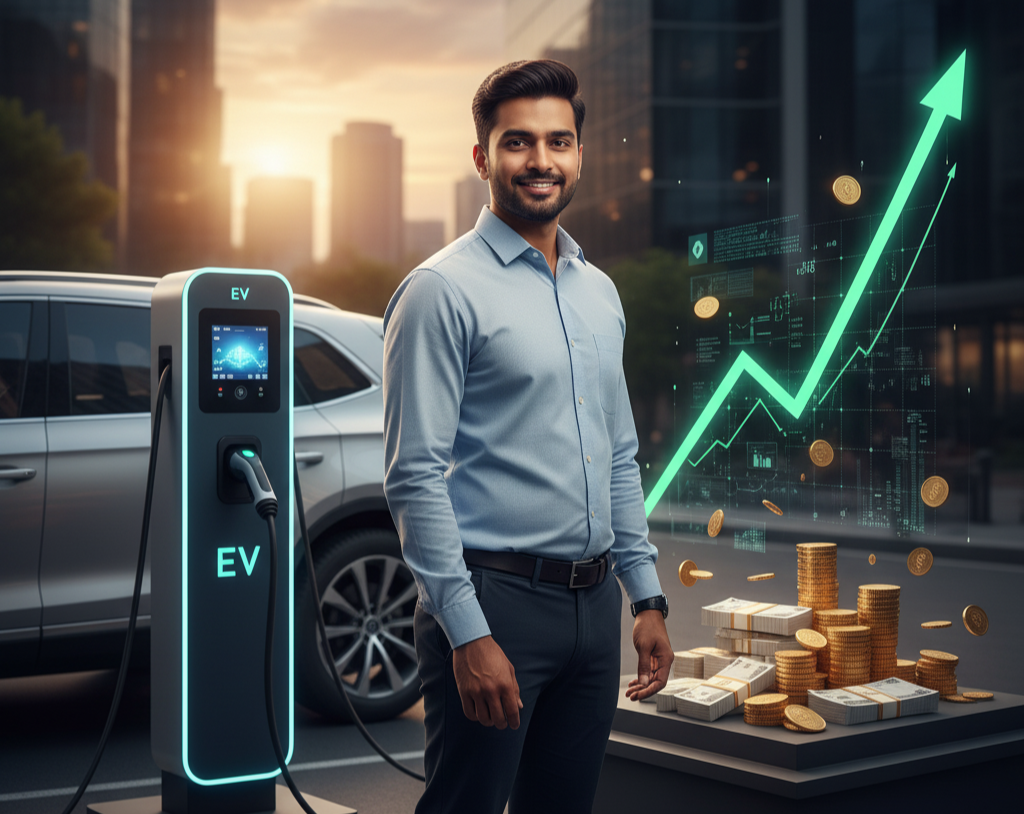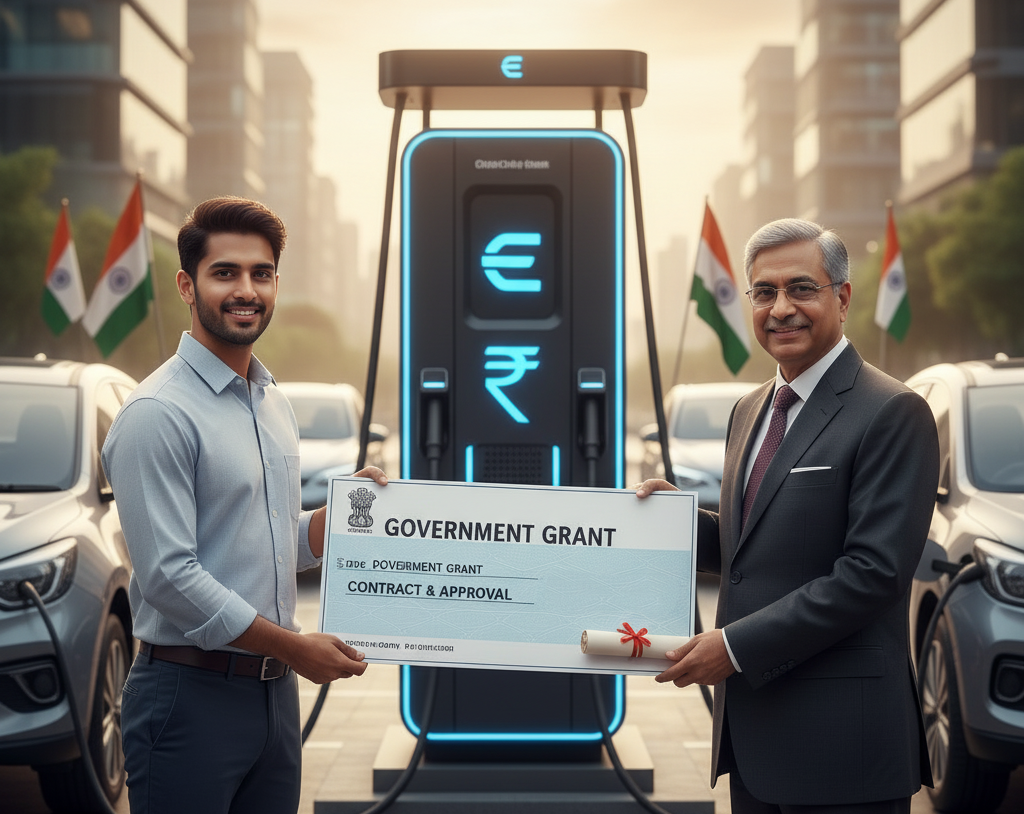If you’ve been watching the electric vehicle trend in India, you’ve probably noticed how fast it’s growing. From scooters to SUVs, everyone wants to go electric. But one thing that still worries most people is charging. Where to charge? Who will set up those charging points?
That’s exactly where EV charging stations come in. Many small business owners, petrol pumps, malls, and even individuals are now thinking to install their own charging stations. But how much does it really cost? And is it profitable? I’ve done some digging around, talked to EV owners, checked real-world examples, and here’s everything explained in plain and simple words.
Why EV Charging Stations Are Important Now
EV sales in India have gone up rapidly in the last few years. Two-wheelers, three-wheelers, and even passenger cars are switching to electric. The government’s push for cleaner energy and rising fuel prices have made electric mobility a serious business opportunity.
The best part is that not just big companies, even small landowners, shops, and parking operators can set up a charging station. EV charging is still new, so early movers can capture a good share of users before the market becomes crowded.
Types of EV Chargers and Their Cost
EV chargers come in different types and power levels. The price mainly depends on charging speed, brand, and type of connection (AC or DC).
Here’s a simple table to understand the approximate costs in India:
| Type of Charger | Power Output | Charging Speed | Suitable For | Approx. Cost Range |
|---|---|---|---|---|
| Level 1 (Slow AC) | 2–3 kW | 6–8 hours | Two-wheelers, small EVs | ₹15,000 – ₹30,000 |
| Level 2 (AC Fast) | 7–22 kW | 3–5 hours | Cars, commercial use | ₹50,000 – ₹1,00,000 |
| DC Fast Charger | 15–50 kW | 45–90 minutes | Four-wheelers, commercial fleets | ₹2.5 lakh – ₹6 lakh |
| DC Ultra Fast Charger | 60–200 kW+ | 15–45 minutes | Highways, public hubs | ₹7 lakh – ₹15 lakh+ |
(Prices vary depending on brand, import duties, and installation needs.)
You see, the cost difference is mainly because DC chargers are faster but also need heavier electrical infrastructure. AC ones are cheaper but slower.
Why Prices Vary So Much
If you check with multiple suppliers, you’ll find huge price gaps for the same power level. That’s because of several hidden factors:
- Brand – Imported chargers cost more, but they come with better warranty and app integration.
- Site setup – If the land needs new wiring or civil work, your expenses can double.
- Electrical upgrades – New transformers, switchgear, or cables add big costs.
- Software integration – Payment system, user tracking, and app connection all add extra fees.
- Land rent – A spot near a mall in Delhi will cost more than a roadside plot in a small city.
So when someone says “EV charger costs ₹5 lakh,” take it with context — it depends on the whole setup, not just the machine.
Cost Breakdown Example (30 kW DC Fast Charger)
Let me give you a simple breakdown example for a 30 kW DC fast charger, which is one of the most common setups used at public stations:
| Expense Head | Estimated Cost (₹) |
|---|---|
| DC Fast Charger Unit | 7,50,000 |
| Installation & Civil Work | 1,80,000 |
| Electrical Upgrades & Cabling | 80,000 |
| Branding, Signage & Payment Setup | 40,000 |
| Annual Land Lease (Average) | 1,50,000 |
| Total Estimated Setup Cost | ₹11,50,000 – ₹12,00,000 |
That’s your starting investment if you want to set up one solid fast charger. If you go for multiple units, your cost per charger may come down slightly.
Two Ways to Set Up a Charging Station
There are mainly two routes you can take:
1. Direct Purchase and Operate
You buy chargers yourself, handle installation, get the power connection, and operate it independently.
- Pros: Full control, better profit margins.
- Cons: Higher investment and you must handle all maintenance and customer support.
2. Franchise or Partnership Model
Many EV charging station networks like Statiq, Tata Power EZ Charge, and ChargeZone offer franchise tie-ups. They handle hardware, app, and backend system, while you provide the space and electricity.
- Pros: Easier to start, less technical headache.
- Cons: Revenue sharing and less control.
Permits and Guidelines to Follow
Before starting, you’ll need a few permissions and safety checks. Usually:
- Approval from the State Electricity Board (like KSEB in Kerala or MSEDCL in Maharashtra)
- Local municipal NOC (if on commercial property)
- Fire safety clearance
- Proper earthing and overload protection systems
Government allows individuals and companies to set up charging stations without a special license, but you must use BIS-certified equipment and follow safety standards.
How Much You Can Earn From EV Charging Station?

Now, this part everyone wants to know — how much you can actually make.
It depends on three things: location, daily users, and electricity tariff.
Let’s take a practical example again:
| Assumptions | Value |
|---|---|
| Charger Type | 30 kW DC Fast Charger |
| Average Cost per kWh | ₹20 |
| Avg. Energy per Vehicle | 30 kWh |
| Vehicles per Month | 400 |
| Monthly Revenue | ₹2,40,000 |
| Avg. Monthly Expenses (electricity, rent, maintenance) | ₹1,20,000 |
| Approx. Monthly Profit | ₹1,20,000 |
So, a busy station can recover its investment in roughly 12–18 months. But low-traffic stations might take longer.
Things That Affect Profitability
- Location: Near malls, offices, or on highways perform better.
- Power Tariff: Some states offer discounted EV charging rates.
- Maintenance Quality: Downtime kills profits.
- Customer Experience: Easy payments and quick response bring repeat customers.
- Competition: Too many nearby chargers divide users.
So yes, like any business, it’s not magic money — it needs a good site and consistent service.
Maintenance and Running Costs
Owning a charging station is not “set and forget.” You’ll need to maintain it properly.
Here are some common running costs:
- Electricity bill – depends on usage.
- Internet & software fees – for app connectivity.
- Annual maintenance contract (AMC) – around ₹15,000–₹30,000 per unit per year.
- Repairs and replacements – cables and plugs wear out.
- Staff or caretaker salary – optional but useful for busy sites.
Keep around 10–15% of your total monthly income reserved for maintenance.
Government Incentives and State Policies

The government supports EV charging through various programs like FAME II and state EV policies. Some states even provide subsidies or reduced electricity tariffs.
Here’s a quick look at a few examples:
| State | Benefit Type | Example |
|---|---|---|
| Delhi | Subsidy + Policy Support | Part of SwitchDelhi initiative, fast approvals |
| Maharashtra | Capital Subsidy | Discount on initial setup cost |
| Kerala | Power Tariff Discount | KSEB provides lower rates for EV charging |
| Gujarat | Land & Infra Support | Easier land allotment for public chargers |
Always check your state’s latest EV policy before applying. It can save a huge chunk of cost.
Risks You Should Keep in Mind
Like every business, this also has risks. Some I noticed while researching:
- Low traffic in initial months can delay profit.
- Rising electricity prices might reduce your margin.
- Technology changes can make old chargers outdated.
- Permit delays or location disputes can cause trouble.
To avoid losses, choose a location wisely and keep a small reserve fund for unexpected expenses.
Tips Before You Start
Here are some personal suggestions before jumping in:
- Start with one or two chargers first, not ten.
- Choose a site where vehicles already stop naturally (like cafés, hospitals, or hotels).
- Tie up with charging apps so people can find your station easily.
- Make sure the area is well lit and safe.
- Offer small extras like washrooms or waiting space if possible.
These little things actually make a big difference.
Real Owner Stories
One person I spoke to in Pune installed two 22 kW AC chargers at a shopping complex. He spent around ₹4 lakh total and now earns about ₹45,000 monthly after expenses.
Another one in Gurgaon set up a fast DC charger on a highway near a restaurant. His investment was around ₹12 lakh, and he started making profit after 15 months because the traffic was steady.
So yes, results depend heavily on where you install it.
Future of EV Charging in India
EV charging is still at an early stage, but the curve is rising. As battery technology improves, charge times will drop and fast chargers will become more common. In the coming years, battery swapping and ultra-fast charging may dominate highways, while AC chargers will handle most city parking spaces.
Many experts believe that every petrol pump, mall, and residential complex will have at least one EV charger by 2030. It’s a good time to enter before the space becomes too crowded.
FAQs
1. How much does it cost to install a basic EV charging station?
A small AC station for scooters or small cars may cost between ₹15,000 and ₹50,000. A DC fast charger setup for cars costs between ₹5 lakh to ₹15 lakh depending on the brand and site condition.
2. Do I need a special license to set up a charger?
No special license is required, but you must follow BIS-certified safety and electrical standards, and take permission from your electricity board.
3. How long does it take to install a charger?
Usually 30–60 days if power is available. If transformer or civil work is needed, it can take longer.
4. How much can I earn from one charging station?
If you get steady usage, monthly profit can range between ₹50,000 to ₹1.5 lakh after expenses.
5. Are there any government subsidies available?
Yes, under schemes like FAME II and state EV policies. Check your state portal for details.
6. Which apps help EV users find charging stations?
Popular ones are Tata Power EZ Charge, Statiq, ElectricPe, and ChargeZone. Listing your charger there increases visibility.
7. Can I install one at my home?
Yes, you can. Small AC chargers are perfect for personal use and need only basic wiring setup.
8. What is the life of an EV charger?
Most chargers last 7–10 years with proper maintenance. Fast chargers may need part replacements sooner.





